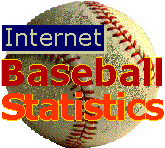
|
Home | Glossary | Team Index | Baseball Links | Baseball Books | Comments |
|
Evaluating Fielding |
While the value of fielding isn't entirely unmeasurable, as Branch Rickey surmised, fielding statistics are more fraught with biases than others. The traditional measure of defensive prowess, fielding percentage, benefits a sure-handed player with limited range. A shortstop who never exerts himself to make a play on balls hit beyond his immediate area might compile a high fielding percentage, but many base hits he made no attempt to prevent will find their way through the infield. Fielding percentage is calculated as (assists plus putouts) divided by (assists plus errors plus putouts).A superior tool for evaluating fielders, other than first basemen and catchers, is range factor. Range factor is simply the number of successful chances a fielder makes per game, calculated as (assists plus putouts) divided by games. Like fielding percentage, range factor has its flaws.
A player on a team laden with strikeout pitchers will have fewer opportunities to make plays in the field. The left/right-handedness of pitchers will affect a player's range factor, as will the pitching staff's groundball/flyball tendencies. Ballparks have an influence, too, especially the amount of outfield space and foul territory available to fielders. While park factor data exists to adjust batting and pitching statistics, it is unfortunately almost unheard of for fielding statistics. In addition, range factor is best calculated using innings played instead of games, but innings played aren't easily available.
For lack of a better measure, though, range factor is still fairly useful to evaluate second and third basemen, shortstops, and outfielders.
In addition to range factor, assists are also used to evaluate the arms of outfielders. The adage is that because baserunners are afraid to challenge them, outfielders with good arms don't get many assists. While this point may be debated, an outfielder with many assists has still succeeded in throwing out a lot of runners, a fact that should not be overlooked. Assists are presented per 162 games, calculated as (assists times 162) divided by games.
Range factor is not a good measure for first basemen, since most of their fielding chances are putouts made simply by receiving throws to first base. Skills important to a first baseman include starting double plays, fielding bunts, making unassisted plays, and handling difficult throws. These abilities are essentially unidentifiable by traditional fielding statistics. In any event, first base is the least demanding defensive position, and it would be highly unusual for a team to retain a first baseman chiefly for his defensive value.
Catchers are also ill-served by range factor, particularly because many of their putouts are accumulated on strikeouts. A catcher acquires his defensive reputation mainly by his ability to throw out baserunners, block pitches in the dirt, and handle a pitching staff. A catcher's capacity to halt the running game is affected by how well his pitchers hold runners. Similarly, while a catcher's earned-run average gives an idea of his competence in handling pitchers, the pitchers themselves have an influence on this statistic, too. Baserunning statistics and earned-run averages for catchers are available from ESPN's player profiles.
First basemen and catchers are evaluated here by fielding percentage, which, while inadequate, says something about the player's ability to handle chances safely. Moreover, assists are used to gauge first basemen and catchers for their ability to reach balls hit into their area as well as to throw out runners. While still an imperfect measure, assists give some idea of fielding skill beyond the misleading influence of putouts for first basemen and catchers. As with outfielders, assists are presented per 162 games.
More accurate and sophisticated means of evaluating fielders have been and are being devised. To see some other methods, check out the zone ratings compiled by STATS, Inc., found in the player profiles on CNN/SI and ESPN. Zone ratings attempt to evaluate fielders based on what percentage of plays they make in their defensive area, or zone. STATS features some other innovative defensive statistics in its annual Baseball Scoreboard. Pete Palmer's fielding runs formula is described in the Total Baseball glossary, and career fielding runs and fielding wins for all major-leaguers are listed in the player records in Total Baseball. Researcher Charlie Saegar wrote an article, "Ready for the Defense," on his approach to fielding statistics, which can be found in the latest edition of the Big Bad Baseball Annual.